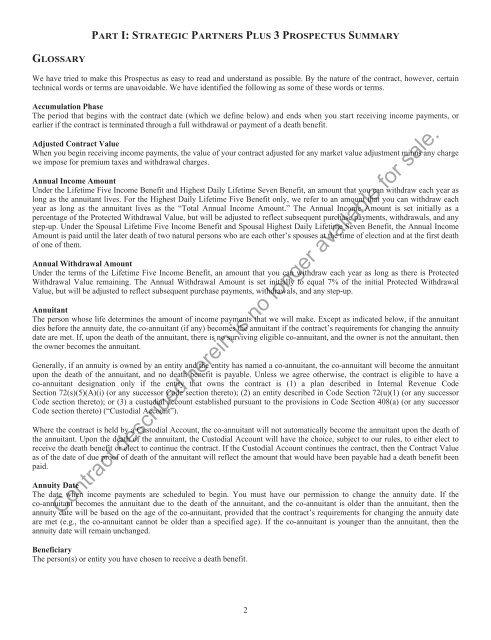Strategic Partners Plus 3 - Prudential Annuities
Strategic Partners Plus 3 - Prudential Annuities
Strategic Partners Plus 3 - Prudential Annuities
- No tags were found...
You also want an ePaper? Increase the reach of your titles
YUMPU automatically turns print PDFs into web optimized ePapers that Google loves.
PART I: STRATEGIC PARTNERS PLUS 3PROSPECTUS SUMMARYGLOSSARYWe have tried to make this Prospectus as easy to read and understand as possible. By the nature of the contract, however, certaintechnical words or terms are unavoidable. We have identified the following as some of these words or terms.Accumulation PhaseThe period that begins with the contract date (which we define below) and ends when you start receiving income payments, orearlier if the contract is terminated through a full withdrawal or payment of a death benefit.Adjusted Contract ValueWhen you begin receiving income payments, the value of your contract adjusted for any market value adjustment minus any chargewe impose for premium taxes and withdrawal charges.Annual Income AmountUnder the Lifetime Five Income Benefit and Highest Daily Lifetime Seven Benefit, an amount that you can withdraw each year aslong as the annuitant lives. For the Highest Daily Lifetime Five Benefit only, we refer to an amount that you can withdraw eachyear as long as the annuitant lives as the “Total Annual Income Amount.” The Annual Income Amount is set initially as apercentage of the Protected Withdrawal Value, but will be adjusted to reflect subsequent purchase payments, withdrawals, and anystep-up. Under the Spousal Lifetime Five Income Benefit and Spousal Highest Daily Lifetime Seven Benefit, the Annual IncomeAmount is paid until the later death of two natural persons who are each other’s spouses at the time of election and at the first deathof one of them.Annual Withdrawal AmountUnder the terms of the Lifetime Five Income Benefit, an amount that you can withdraw each year as long as there is ProtectedWithdrawal Value remaining. The Annual Withdrawal Amount is set initially to equal 7% of the initial Protected WithdrawalValue, but will be adjusted to reflect subsequent purchase payments, withdrawals, and any step-up.AnnuitantThe person whose life determines the amount of income payments that we will make. Except as indicated below, if the annuitantdies before the annuity date, the co-annuitant (if any) becomes the annuitant if the contract’s requirements for changing the annuitydate are met. If, upon the death of the annuitant, there is no surviving eligible co-annuitant, and the owner is not the annuitant, thenthe owner becomes the annuitant.Generally, if an annuity is owned by an entity and the entity has named a co-annuitant, the co-annuitant will become the annuitantupon the death of the annuitant, and no death benefit is payable. Unless we agree otherwise, the contract is eligible to have aco-annuitant designation only if the entity that owns the contract is (1) a plan described in Internal Revenue CodeSection 72(s)(5)(A)(i) (or any successor Code section thereto); (2) an entity described in Code Section 72(u)(1) (or any successorCode section thereto); or (3) a custodial account established pursuant to the provisions in Code Section 408(a) (or any successorCode section thereto) (“Custodial Account”).Where the contract is held by a Custodial Account, the co-annuitant will not automatically become the annuitant upon the death ofthe annuitant. Upon the death of the annuitant, the Custodial Account will have the choice, subject to our rules, to either elect toreceive the death benefit or elect to continue the contract. If the Custodial Account continues the contract, then the Contract Valueas of the date of due proof of death of the annuitant will reflect the amount that would have been payable had a death benefit beenpaid.Annuity DateThe date when income payments are scheduled to begin. You must have our permission to change the annuity date. If theco-annuitant becomes the annuitant due to the death of the annuitant, and the co-annuitant is older than the annuitant, then theannuity date will be based on the age of the co-annuitant, provided that the contract’s requirements for changing the annuity dateare met (e.g., the co-annuitant cannot be older than a specified age). If the co-annuitant is younger than the annuitant, then theannuity date will remain unchanged.Contract described herein is no longer available for sale.BeneficiaryThe person(s) or entity you have chosen to receive a death benefit.2
















